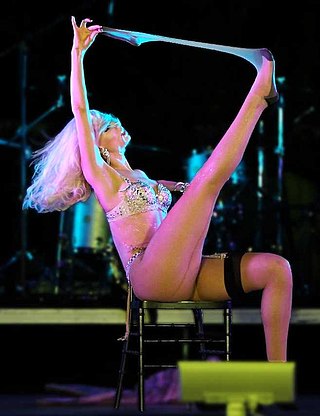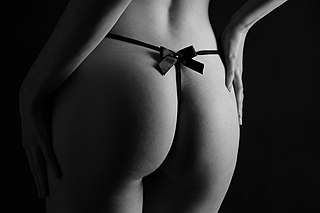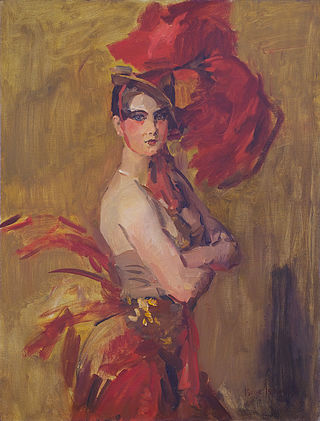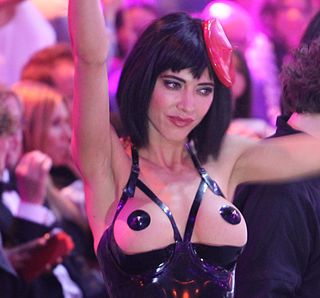
A striptease is an erotic or exotic dance in which the performer gradually undresses, either partly or completely, in a seductive and sexually suggestive manner. The person who performs a striptease is commonly known as a "stripper" or an "exotic" or "burlesque" dancer.

A stripper or exotic dancer is a person whose occupation involves performing striptease in a public adult entertainment venue such as a strip club. At times, a stripper may be hired to perform at private events.

A burlesque is a literary, dramatic or musical work intended to cause laughter by caricaturing the manner or spirit of serious works, or by ludicrous treatment of their subjects. The word derives from the Italian burlesco, which, in turn, is derived from the Italian burla – a joke, ridicule or mockery.

A G-string is a garment consisting of a narrow piece of material that covers the genitals, a string-like piece that passes between the buttocks, and a very thin waistband around the hips. There are designs for both women and men. Men's G-strings are similar to women's but have a front pouch that covers the genitals. G-strings are typically worn as underwear or swimwear or as part of the costume of an exotic dancer.

An erotic dance is a dance that provides erotic entertainment with the objective to erotically stimulate or sexually arouse viewers. Erotic dance is one of several major dance categories based on purpose, such as ceremonial, competitive, performance and social dance.

The Burlesque Hall of Fame (BHOF) is the world's only museum dedicated to the history, preservation, and future of the art of burlesque. Located in the Las Vegas Arts district at 1027 S Main st. #110, BHOF is a tourist destination and non-profit 501 (c)(3) educational organization offering tours of its vast Collection of costumes, memorabilia, props and ephemera from burlesque's heyday through contemporary practice; classes for individuals and groups at all levels including beginner; movie screenings; research access for students and journalists; and a gift shop.

A strip club is a venue where strippers provide adult entertainment, predominantly in the form of striptease or other erotic dances. Strip clubs typically adopt a nightclub or bar style, and can also adopt a theatre or cabaret-style. American-style strip clubs began to appear outside North America after World War II, arriving in Asia in the late 1980s and Europe in 1978, where they competed against the local English and French styles of striptease and erotic performances.

A showgirl is a female performer in a theatrical revue who wears an exotic and revealing costume and in some shows may appear topless. Showgirls are usually dancers, sometimes performing as chorus girls, burlesque dancers or fan dancers, and many are classically trained with skills in ballet. The term showgirl is also sometimes used by strippers and some strip clubs use it as part of their business name.

Pasties are patches that cover a person's nipples and areolae, typically self-adhesive or affixed with adhesive. They originated as part of burlesque shows, allowing dancers to perform fully topless without exposing the nipples in order to provide a commercial form of bare-breasted entertainment. Pasties are also, at times, used while sunbathing, worn by strippers and showgirls, or as a form of protest during women's rights events such as Go Topless Day. In some cases this is to avoid potential prosecution under indecency laws.

Chippendales is a touring dance troupe best known for its male striptease performances and for its dancers' distinctive upper body costume of a bow tie, collar, and shirt cuffs worn on an otherwise bare torso.

The Miss Exotic World Pageant is an annual neo-burlesque pageant and convention, and is the annual showcase event the Burlesque Hall of Fame. The pageant, sometimes referred to as the "Miss America of Burlesque", attracts former burlesque queens from past decades, as well as current participants of the neo-burlesque scene. The pageant consists of burlesque performances spanning a weekend, culminating with the competition to crown a single performer as Miss Exotic World. Because of the significance of the Exotic World Burlesque Museum to the burlesque community, winning the pageant is considered a top honor for a burlesque performer.

Michelle L'amour is an American neo-burlesque performer who grew up in Orland Park, Illinois. In 2006, she performed stripteases on NBC's America's Got Talent, Showtime's Sexual Healing, and in small touring performances. Her tagline is "The Ass That Goes POW!" and she sells related promotional products.

Catherine D’lish is an American performance artist specializing in classical strip tease and burlesque.
Hinda Wausau (1906–1980) aka Hinda Wassau, Hinda Wasau, or Hindu Wausau, was a star stripteaser in burlesque. She claimed, and has been credited with, inadvertently inventing the striptease around 1928 at either the Haymarket or State-Congress Theater in Chicago when her costume started coming off during a shimmy dance.

Anna Frangiosa is a Philadelphia-based theater artist, costume designer, burlesque performer, director, instructor and model.

Dirty Martini is an American burlesque dancer, pin-up model and dance teacher.

American burlesque is a genre of variety show derived from elements of Victorian burlesque, music hall, and minstrel shows. Burlesque became popular in the United States in the late 1860s and slowly evolved to feature ribald comedy and female nudity. By the late 1920s, the striptease element overshadowed the comedy and subjected burlesque to extensive local legislation. Burlesque gradually lost its popularity, beginning in the 1940s. A number of producers sought to capitalize on nostalgia for the entertainment by recreating burlesque on the stage and in Hollywood films from the 1930s to the 1960s. There has been a resurgence of interest in this format since the 1990s.
The Kiss Kiss Cabaret is a live weekly variety show presenting vaudeville and neo-burlesque on Friday nights at the Uptown Broadway Building in Chicago, IL.

Jett Adore is an American burlesque dancer. He has performed as part of Stage Door Johnnies, Chicago's only all-male burlesque troop. Due to his career success, Adore has been referred to as the Prince of Boylesque and is an inductee of the Burlesque Hall of Fame.
Georgia Sothern (1913–1981), born Hazel Anderson, was a burlesque dancer and vaudeville performer. She was known for her striptease performances. She gave an interview to The Harvard Crimson during a trip to the Old Howard Athenaeum in Boston during 1939. She toured New York Philadelphia, Boston, Buffalo, and Miami. She was a red-head. One of her performances was captured in a Film Theatarettes short film. She wrote her memoir titled Georgia: A Life in Burlesque. She had a series of marriages.





















